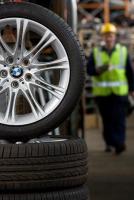Used Land Rover Discovery Axle
All used Land Rover Discovery Axle listed on Breakeryard.com are tested, original (OEM) manufacturer parts and come with a 14 day money back guarantee. Breakeryard.com list cheap new OES or aftermarket car parts at discounted prices or used OEM car parts up to 80% cheaper than main dealer prices for Land Rover Discovery from premium breaker yards from across the UK.
About Axle
What is the axle/what does it do?
The term axle is loosely used to describe the shaft or two half shaft connected to transverse wheels. It can be a load bearing shaft or a shaft that drives the wheels.
Getting into the details of the axle
On a rear wheel drive vehicles the drive to the wheels comes from the propeller shaft which runs under the center of the vehicle, front to back, from the gearbox to the differential drive which is located centrally between the two rear wheels.The differential is a set of cogs which turns the drive rotation ninety degrees to each back wheel.The Differential, through the clever design and setup of the cogs, also allows the rear wheels to turn at different speeds necessary when the vehicle is turning. The term rear axle can refer to the complete set of two half shafts or half axles and the differential.
On front wheel drive vehicles there are two half shaft/axles connected from a differential that is usually combined in the gearbox via constant velocity joints which allows the front wheels to turn for steering the vehicle while under torque from the rotating shaft/axle. These CV joints are usually encased in a rubber sleeve containing lubricant grease. The rear wheels of the front wheel drive vehicle have stub axles which are usually short and part of an independent suspension system on each rear wheel.
What if something goes wrong with the axle?
Although usually very resilient, problems can occur in rear wheel drive vehicles in the differential with the wear of cogs, which maybe caused by lack of lubrication due to leaks. In front wheel drive vehicles the most common problem is the breakdown of the rubber sleeve on the CV joints connecting the drive shaft from the gearbox to the half shaft axle and to the driving wheels. The CV joints can suffer damage if the damaged rubber sleeves are not replaced, this is caused by wear with the ingression of dust and grit and loss of lubricant. Another cause of damage can be the collision with obstructions in the road or running up high kerbs etc.
Land Rover trivia
- Land Rover was notorious for trying to find ways to avoid paying taxes and extended that to their customers too. They built the Defender 110 so that it could (just about) fit 12 people! Technically, that meant that they could class it as a bus, and owners didn't have to pay standard road tax.
- Land Rover was the two-decade standout winner of the Camel Trophy, a gruelling off-road challenge that sees vehicles compete in Siberia, the Sahara, Australia, and other hostile terrains.
- One of the most unique vehicles ever was the floating SUV designed and built by Land Rover. Unfortunately, the Floating Ninety Defender led many drivers to believe that their own Land Rovers could also float, and many cars were driven into lakes as a result.
- In the 1950s, you could buy yourself a Land Rover with tank tracks instead of wheels. Known as the Cuthbertson Version, it was intended for use by farmers and was tested by driving across the Scottish Highlands.
- Although the first Land Rover was designed in 1947 (by Maurice Wilks), the company wasn't actually founded until 1978!





